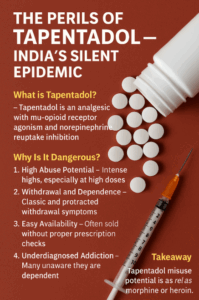The Perils of Tapentadol – India’s Silent Epidemic
Introduction
Tapentadol – once hailed as a safer alternative to other opioids – is now quietly fueling a dangerous wave of addiction across India. Marketed for moderate to severe pain, this dual-action drug (opioid receptor agonist + norepinephrine reuptake inhibitor) is often assumed to be safer than its counterparts. But behind the prescription pad lies a growing public health threat.

What is Tapentadol?
Tapentadol is a centrally acting analgesic with a dual mechanism:
-
Mu-opioid receptor agonism (similar to morphine)
-
Norepinephrine reuptake inhibition (like certain antidepressants)
This makes it effective for both nociceptive and neuropathic pain — but also increases its abuse potential.
Why Is It Dangerous?
-
High Abuse Potential
-
Though marketed as “less euphoric,” tapentadol, especially at high doses or via IV, can induce intense highs.
-
Users often crush tablets for injection, risking embolism, sepsis, and overdose.
-
-
Withdrawal and Dependence
-
Sudden cessation causes classic opioid withdrawal: restlessness, diarrhea, myalgia, insomnia.
-
Protracted withdrawal (PAWS) may include anxiety, depression, fatigue, and even tactile hallucinations.
-
-
Easy Availability
-
Though classified as a Schedule H1 drug in India, it is often sold without proper prescription checks, making it easily accessible to youth and laborers seeking relief from pain and fatigue.
-
-
Underdiagnosed Addiction
-
Many individuals using tapentadol are unaware they are dependent. They may seek it under the guise of chronic pain, unaware of the cycle they’re caught in.
-
Case Snapshot (Based on Clinical Observations)
-
Patient: 28-year-old male mechanic in Chennai
-
History: Lower back pain after injury, prescribed tapentadol 50 mg BID.
-
Progression: Over a year, escalated to 600 mg/day via oral and occasional IV use. Sought help after experiencing crawling sensations under the skin post-withdrawal.
-
Diagnosis: Tapentadol dependence with PAWS.
-
Treatment: Buprenorphine-naloxone, supportive therapy, family education.
What Clinicians & Patients Must Know
-
It is NOT a weak opioid.
-
Tapering must be supervised.
-
IV use of oral tablets is extremely dangerous.
-
Monitoring for signs of dependence must begin at the time of prescription.
Takeaway
Tapentadol may appear “milder,” but its misuse potential is as real as morphine or heroin. It’s time we start treating it with the seriousness it deserves.
In the next part of this series, we’ll explore the three classes of opioids — natural, semi-synthetic, and synthetic — and how each behaves differently in the body.
🔚 Final Thoughts
Tapentadol isn’t just another painkiller—it’s a potential gateway to a larger public health crisis if left unchecked. As prescribers, families, and society, it’s time we pay attention to this silent epidemic before it becomes louder and more destructive.
👨⚕️ About the Author
Dr. Srinivas Rajkumar T, MBBS, MD (Psychiatry)
Consultant Psychiatrist | Apollo Clinics, Velachery & Tambaram
Founder – srinivasaiims.com | Mental Health & Addiction Recovery Advocate
📍 Chennai | Online & Offline Consultations Available
I specialize in managing addiction, emotional health, and cognitive issues through evidence-based, affordable care. If you or a loved one is struggling with opioid use or withdrawal, I’m here to help—with empathy, structure, and solutions.
🖥️ Read more articles like this at srinivasaiims.com
📞 Call or WhatsApp for appointments: 85951 55808
📩 Follow my updates on LinkedIn: Dr. Srinivas Rajkumar T